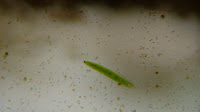The biggest difference since I last saw my aquarium is the developement of a new algae. This new algae looks like short nylon hairs and literaly everywhere, never before in the aquarium has there been so much of one species as there is now. The eugenoids and the rotifers are still present but their numbers have significantly died down and the euglenoids have stopped moving which may be a sign that they are dieing out. I have managed to identify a couple Arcella, they are this yellow-orange ball looking blob that does not move. Arcella is a testate amoeba. The most prevelent moving organism is Dileptus, Dileptus is a predatory cilitate and I believe that it is to blame for the dieing out of other organism like rotifers.
Patterson D. J. 1992 Free-living Freshwater Protazoa. Washington D.C. Manson
Publishing
Sunday, November 16, 2008
Sunday, November 9, 2008
The aquarium has not changed much since the last post. Sadly the analid named herbert passed away along with all of the worms the lived in the dirt, now there are new ciliates, I have been able to identify paramecium and spirostomum and there are many other kinds of tiny cilitates that can't be seen very well. the entire aquarium is slowly being filled with colorful specks that I think are mostly algea.
Patterson D. J. 1992 Free-living Freshwater Protazoa. Washington D.C. Manson
Publishing
Patterson D. J. 1992 Free-living Freshwater Protazoa. Washington D.C. Manson
Publishing
Sunday, November 2, 2008



One week ago when the food pellet was put in there was an increase in actvity in the aquarium. The whole thing swarmed with rotifers but they were mainly concentrated near the food pellet. annelids started to apear in the dirt, they are the largest organism in the aquarium and mainly move around near the dirt. Now that the food pellet is gone many of the rotifers are gone and dinoflagellates have started to apear, unlike the interesting stuff they are staionary. The first picture is of a dinoflagellate, the second picture is of a rotifer and the thrid picture has an annelid in it.
Patterson D. J. 1992 Free-living Freshwater Protazoa. Washington D.C. Manson
Publishing
Tuesday, October 28, 2008
There seemed to be three distinct bateria in my aquarium the first is an oval shaped thing that seems to spin in one spot. The second is a rod shaped bateria that is either composed of one rod or two segments attached head to tail, they move in one direction and they are also pretty fast. The final and most interesting bateria are these things with one long flagela and what appears to be horns. They are mostly transparent except for a red spot on what I think is the head, they have the ability to control their movement because they can move in any direction.
Patterson D. J. 1992 Free-living Freshwater Protazoa. Washington D.C. Manson
Publishing
Patterson D. J. 1992 Free-living Freshwater Protazoa. Washington D.C. Manson
Publishing
first post
The dots on my micro aquarium are yellow red blue, I used water from tank 1 and I had both plants A and B
Subscribe to:
Comments (Atom)